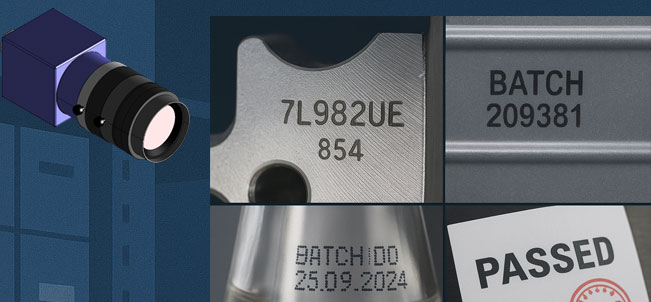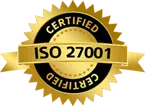Intelgic OCR & Text Reading AI
Published on: Oct 23, 2025

Written by: Content team, Intelgic
Reading Any Text, from Any Surface, in Any Langua
Introduction
In today’s manufacturing and industrial ecosystem, products move faster than ever — from production lines to warehouses to customer sites. Yet, one of the most fundamental tasks in this process remains deceptively complex: reading text from parts and products.
Serial numbers, batch codes, laser-marked IDs, labels, and inspection stamps are everywhere — but they appear on a variety of materials, surfaces, and shapes. These can be shiny metals, textured plastics, transparent glass, coated surfaces, or paper labels.
Traditional Optical Character Recognition (OCR) systems were designed for flat, printed text under perfect lighting — not for real-world factory environments. That’s where Intelgic’s AI-powered OCR & Text Reading System comes in.
Intelgic has built an advanced AI vision platform that can read any text, from any surface, in any language, and verify or transmit it to your enterprise systems for traceability, compliance, and analytics.

The Industrial Challenge: Why Reading Text is Hard
Text recognition in industrial settings is more complex than it appears. Several real-world challenges make it nearly impossible for conventional OCR to perform reliably:
- Surface reflections: Polished metals and curved parts cause glare that hides engraved or laser-etched text.
- Low contrast markings: Laser or dot-peen marks often have minimal contrast against the base material.
- Multiple materials: The same product family may use aluminum, painted steel, or plastic — each reflecting light differently.
- Varied marking methods: Printed ink, etching, embossing, engraving, or stamping each create unique visual characteristics.
- Dust, oil, and aging: Real-world factory conditions cause dirt, oxidation, and wear, degrading mark clarity.
- Multilingual content: Global manufacturing uses part codes, letters, and scripts in many languages and combinations (e.g., Chinese + English or Arabic + numerals).
- Curved and 3D surfaces: On cylindrical or irregular parts, characters may warp or appear non-linear.
Intelgic’s AI OCR was purpose-built to overcome each of these challenges.

Intelgic OCR & Text Reading AI: The Technology
Intelgic’s OCR system is powered by its proprietary Live Vision AI platform — a modular vision-AI engine that combines deep learning, advanced image processing, and adaptive illumination control.
It can read numbers, letters, symbols, and marks from virtually any surface — reflective or matte, transparent or textured — and in multiple languages including English, Chinese, Hindi, Japanese, Korean, Arabic, Cyrillic, and Latin-based languages.
Core Functionalities
- Multi-language OCR: Detects and recognizes text in multiple scripts and languages simultaneously.
- Surface-independent vision: Specialized preprocessing removes glare, adjusts lighting geometry, and normalizes reflectivity.
- Smart text localization: AI models locate regions of interest (ROIs) even when text alignment or angle varies.
- Laser and Dot-Peen Optimization: Enhanced feature extraction for low-contrast and micro-engraved text.
- Symbol & Mark Reading: Recognizes industrial symbols, logos, arrows, or approval stamps along with text.
Confidence Scoring: Provides accuracy metrics for each recognition result and flags uncertain reads for review.
How It Works
1. Image Acquisition
High-resolution industrial cameras (5–65 MP) or line-scan systems capture images of the part under carefully tuned lighting — such as coaxial, dome, or low-angle illumination.
Intelgic’s engineers select the camera, lens, and lighting geometry that deliver maximum contrast for the target surface.
2. Image Preprocessing
Before OCR is applied, AI-based filters enhance text visibility by:
- Removing glare and reflections.
- Equalizing brightness and contrast.
- Correcting geometric distortion on curved or angled surfaces.
- Isolating text zones from background noise or texture.
3. Text Detection
Deep learning models detect text regions, even when they are:
- Non-linear (curved surfaces)
- Multi-line (multi-row serials)
- Embedded in noisy or patterned backgrounds
4. Character Recognition
The OCR module applies neural networks trained on millions of industrial text samples across languages and marking types. It can identify printed, etched, stamped, or engraved text.
5. Validation and Integration
Recognized text is validated through:
- Pattern rules (e.g., serial format, checksum).
- Database matching (compare to part master list).
- Cross-reference verification (ERP/MES integration).
Once validated, results can be sent to external systems via REST APIs, OPC-UA, or PLC I/O signals.
6. Reporting and Analytics
Every read is logged with its image, timestamp, and confidence score. Intelgic’s Digital Quality Certificate (DQC) system generates reports for traceability and compliance.

Reading Text from Any Surface
Intelgic’s OCR excels on difficult industrial materials where conventional systems fail:
|
Material Type |
Example Applications |
AI Technique Used |
|
Metal |
Laser-marked steel tools, aluminum housings |
Adaptive illumination & specular reflection control |
|
Plastic |
Molded parts, bottles, and packaging |
Texture suppression & contrast normalization |
|
Glass |
Automotive glass, lenses, and bottles |
Polarized lighting & edge enhancement |
|
Paper/Label |
Packaging, barcodes, printed tags |
Standard OCR with multilingual capability |
|
Painted/Coated Surface |
Powder-coated metal, color markings |
Color segmentation & reflectivity balancing |
Reading in Any Language
Intelgic’s OCR models are trained on a diverse multilingual dataset — enabling it to read global manufacturing labels and part codes seamlessly.
- English, German, French, Spanish, Italian
- Hindi, Bengali, Tamil, Telugu
- Chinese (Simplified and Traditional), Japanese, Korean
- Arabic, Persian, Urdu
- Cyrillic (Russian, Ukrainian, etc.)
- Latin-based scripts and combinations (alphanumeric mixes)
This makes Intelgic’s OCR uniquely suited for export manufacturing, global supply chains, and multi-country production lines.
Integration & Cloud Connectivity
Intelgic OCR can be deployed in multiple ways:
- Inline System: Integrated with cameras on conveyors or robotic stations for automated inspection.
- Offline Station: Standalone inspection terminal for manual loading.
- Mobile App: Use Intelgic’s ready mobile OCR app to capture and read parts on the go.
- Cloud OCR API: Process captured images from remote locations and return recognized text to your ERP or database.
Data can be transmitted securely to the Intelgic Cloud, enabling centralized storage, analytics, and Digital Quality Certificate generation.
Applications Across Industries
|
Industry |
Example Use Cases |
|
Automotive |
Reading VIN, serial numbers, or laser-etched codes on metal parts |
|
Medical Devices |
Reading micro-text and engraved identifiers for regulatory traceability |
|
Electronics & PCB |
Reading printed component codes, batch numbers, or wafer IDs |
|
Aerospace |
Capturing engraved or stamped part IDs on titanium or composite materials |
|
Packaging & FMCG |
Reading lot numbers, expiry dates, or multilingual labels |
|
Steel & Metal Fabrication |
Reading etched heat codes or product identifiers on coils, sheets, and pipes |
Benefits of Intelgic OCR & Text Reading AI
- Universal readability: Works across materials, languages, and marking types.
- High accuracy: AI-driven preprocessing and deep learning ensure exceptional reliability.
- Seamless integration: Connects directly with PLCs, MES, or ERP systems.
- Improved traceability: Every part can be tracked and verified digitally.
- Zero manual data entry: Automated text capture eliminates transcription errors.
- Scalable architecture: Available as turnkey system, SDK, or cloud API.
- Reduced inspection cost: One platform handles all part types and text formats.
Conclusion
Reading text from industrial parts is not just about OCR — it’s about understanding surfaces, lighting, and manufacturing realities. Intelgic OCR & Text Reading AI represents the evolution of machine vision for modern industry — reading anything, from anywhere, in any language.
By combining advanced imaging, adaptive AI, and intelligent data validation, Intelgic’s solution delivers universal text reading capability — from laser marks on stainless steel to printed batch codes on packaging.
For manufacturers seeking traceability, automation, and quality assurance, Intelgic OCR is the bridge between the physical world of parts and the digital world of data.

